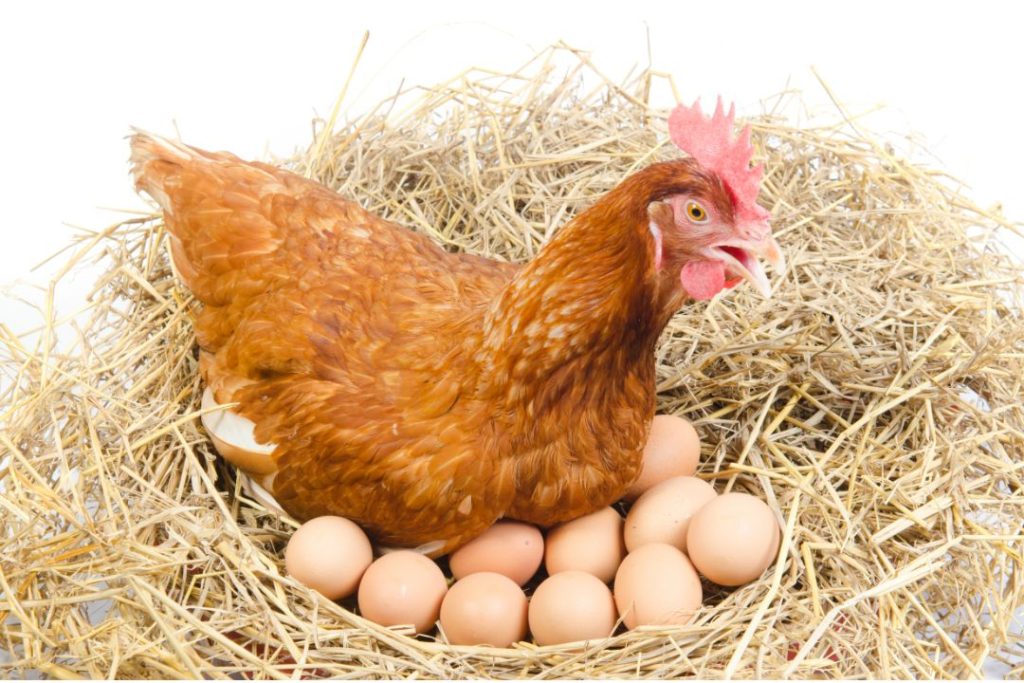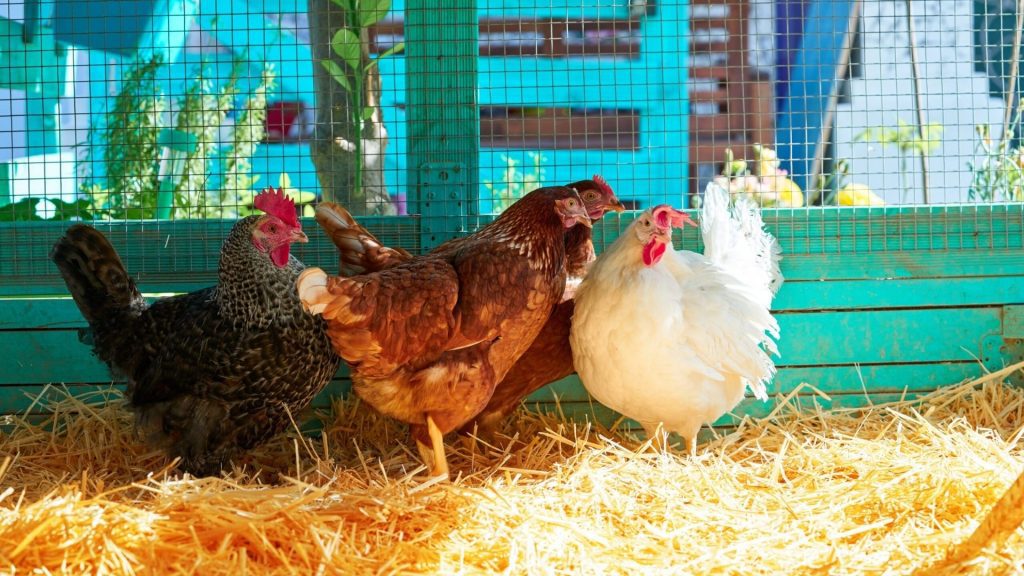One question often pops up in the backyard poultry-keeping world, especially among new enthusiasts: “Can chickens lay eggs without a rooster?” The short answer is yes. Certainly, your hen can lay eggs without a rooster. Chickens can indeed lay eggs without a rooster being present.
Hens, or female chickens, have a natural reproductive cycle that involves laying eggs, whether or not a rooster is available to fertilize them. This means that hens will lay eggs regularly without needing a rooster around.
However, this guide is a must-go for all seasoned poultry keepers or just starting out. So, lets start:
Where Do Eggs Come Out Of A Chicken?
Before we dive into the role of roosters in egg-laying, it’s essential to understand the basic anatomy of a chicken. Chickens have a single reproductive tract, where both the egg and waste products exit, known as the vent.
This might raise eyebrows, but nature has designed a perfect system to keep the egg clean and bacteria-free. A hen’s body is a marvel of nature, designed meticulously to facilitate the process of egg production and laying.
Let’s explore the journey of an egg inside a hen’s body, emphasizing the critical areas of the oviduct and the vent.
The Oviduct: The Birthplace of Eggs
A remarkable organ, the oviduct, is where the genesis of an egg takes place. This tubular structure houses different sections, each playing a pivotal role in egg formation spanning a considerable length.
- Infundibulum: The initial segment captures the yolk released from the ovary. Fertilization occurs here if sperm is present.
- Magnum: Here, the egg receives its layers of albumen, a rich source of protein.
- Isthmus: A narrower region where the inner and outer shell membranes form, providing protection.
- Shell Gland: The egg acquires its hard shell here, which takes nearly 20 hours.
- Vagina: The final section before the vent, where the egg receives a protective coating called the bloom or cuticle, safeguarding it from bacterial invasion.
The oviduct’s role is pivotal in answering the question, “Can chickens lay eggs without a rooster?” The answer lies in the infundibulum, where fertilization would occur if a rooster were involved but is not a prerequisite for egg laying.
The Vent: Exit Door for the Eggs
A vital structure in the egg-laying process is the vent. Situated at the end of the reproductive tract, it serves a dual purpose, also being the exit point for waste materials. Despite this, a meticulous design ensures the egg remains uncontaminated during its exit.
- Hygienic Design: Nature has devised a system where the egg never comes into contact with feces, maintaining hygiene.
- Bloom Application: Just before the egg exits, it receives a coating, adding a protective layer against bacteria.
- Muscular Control: The vent, equipped with strong muscles, facilitates the smooth exit of the egg, a testament to nature’s perfect design.
The vent’s functionality clarifies the hygiene and safety measures nature has endowed hens with, ensuring the production of clean and healthy eggs.
The Journey of an Egg: A Step-by-Step Guide
Visualizing an egg’s step-by-step journey can be enlightening to grasp where eggs come out of hens fully. Let’s walk through this incredible journey:
- Ovary: The journey begins with the release of a yolk from the hen’s ovary, occurring almost daily in young hens.
- Infundibulum: The yolk enters this section, where it stays for about 15-30 minutes, a window for potential fertilization.
- Magnum: Over the next 3 hours, the egg receives layers of albumen, providing nutrients and protection.
- Isthmus: In this region, lasting about 1.5 hours, the egg gains its membranes, crucial for shielding the contents.
- Shell Gland: The egg spends the longest time here, around 20 hours, receiving its hard, protective shell.
- Vagina and Vent: Finally, the egg moves to the vagina, receiving a protective bloom before exiting through the vent, marking the end of a remarkable journey.
Through this detailed exploration, we have unraveled the mystery surrounding the question, “Can chickens lay eggs without a rooster?” And hopefully you understood the intricate process that takes place within a hen’s body, leading to the formation and laying of eggs.
What is the Chicken’s Egg-Laying Process?
The egg-laying process in chickens is a fascinating journey that begins with ovulation. It encompasses the egg white and the shell formation, culminating in the egg laying. Each stage is a marvel of biological engineering. In fact, each step showcases the hen’s ability to create a nurturing environment for the egg all by herself.
Ovulation
A hen’s reproductive cycle initiates with ovulation. During this phase, the yolk, a yellow spherical part rich in nutrients, detaches from the hen’s ovary.
This event marks the beginning of a remarkable journey that doesn’t necessitate a rooster’s involvement. The yolk’s release is a natural process that occurs in a healthy hen, typically on a daily or near-daily basis.
Formation of the Egg White
The yolk embarks on a transformative voyage down the oviduct just after ovulation. Gradually, layers of albumen, commonly known as egg white, envelop the yolk, offering it protection and nourishment.
This egg white harbors proteins and water, providing a cushioning effect to the delicate yolk. The formation of the egg white is a meticulous process, ensuring the yolk remains centered and safeguarded. Roosters play no part in this stage; the hen single-handedly facilitates the nurturing environment for the egg.
Shell Formation
As we further explore the question, “Can chickens lay eggs without a rooster?” we reach the shell formation stage. The egg, now enveloped in albumen, reaches the shell gland. Here, it spends approximately 20 hours, during which it receives its hard, protective outer shell.
Calcium carbonate is the primary component, giving the shell strength and rigidity. This shell protects the inner contents and allows for the exchange of gases through its porous structure. It maintains the necessary conditions for the egg’s preservation.
The shell’s formation is a testament to the hen’s remarkable biological processes, operating seamlessly without a rooster’s presence.
Laying the Egg
The culmination of this meticulous process is the laying of the egg. Through a process governed by her biological clock, the hen lays the fully formed egg. This act is a natural conclusion to the egg’s journey.
It started with the release of a yolk and saw the egg white and shell formation. The egg laying is an autonomous process independent of a rooster’s presence.
What Is Rooster’s Role in Egg Fertility?
Roosters bring a vital element to the table — fertility. While hens lay eggs autonomously, roosters ensure the eggs are fertile. Fertility means the eggs harbor life, possessing the potential to develop into chicks.
The Mating Process
During mating, the rooster transfers sperm. Then, the sperm travels to the oviduct and fertilizes the ovum. This process is the cornerstone of egg fertility, setting the stage for potential life.
Fertilization: A Detailed Look
Fertilization takes place when the sperm meets the egg. The rooster facilitates this process. This meeting is a delicate dance, a union that sparks the genesis of new life. Fertilization is the critical juncture where the rooster’s role becomes pivotal.
Egg Development Post Fertilization
Post fertilization, the egg transforms. The fertilized egg embarks on a journey, developing and nurturing the embryo. Here, the rooster’s contribution, albeit indirect, remains crucial, having initiated the life cycle.
Incubation: The Next Step
Incubation follows the laying of the fertilized egg. During this period, the egg needs warmth and humidity, conditions necessary for the embryo to develop. The rooster sometimes assists in maintaining these conditions, showcasing a nurturing side.
Rooster’s Protective Role
Beyond fertilization, roosters play a protective role. Roosters guard the nest and ensure your hen’s safety.
Fertilized and Unfertilized Eggs Differences
Fertilized eggs bear the potential for life. It answers affirmatively to “Can chickens lay eggs without a rooster?”
The Visual Difference
Spotting the difference between fertilized and unfertilized eggs is possible through candling or observing the blastodisc. Knowledge of these differences is vital in breeding, where the rooster’s role is indispensable.
Rooster’s Contribution to Genetic Diversity
Roosters contribute to genetic diversity, enhancing the flock’s health and vitality by introducing new genetic material. This contribution is the rooster’s silent yet significant role in the fertility process.
Rooster’s Role in a Sustainable System
In a sustainable farming system, roosters are integral, facilitating natural breeding and contributing to a balanced ecosystem. Their role goes beyond fertilization, encompassing a broader spectrum of sustainable practices.
Does a Rooster Have to Fertilize an Egg?
Roosters play a pivotal role in the fertilization process. Their involvement ensures the eggs laid by the hens have the potential to develop into chicks. However, their presence is not mandatory for hens to lay eggs, as hens naturally lay eggs irrespective of fertilization.
Identifying Fertilized Eggs
Spotting fertilized eggs can be a meticulous task. Generally, a more prominent blastodisc indicates fertilization. This blastodisc manifests as a faint white spot on the yolk, a sign of potential life within the egg.
The Blastodisc and Blastoderm
Understanding the terminology is key. A blastodisc transforms into a blastoderm post-fertilization, marking the beginning of embryonic development. Recognizing this transformation can be a vital skill in poultry breeding.
Egg Candling: A Useful Technique
Employing egg candling techniques can aid in identifying fertilized eggs. This method involves shining a light through the egg to observe its internal structures, a vital tool in the hands of breeders.
Nutritional Differences
Exploring the fertilized versus unfertilized egg’s nutritional landscape reveals subtle differences. Some argue that fertilized eggs offer a richer nutrient profile, although scientific consensus remains elusive.
Culinary Preferences
In culinary circles, a preference might exist for fertilized or unfertilized eggs based on individual tastes and beliefs. Understanding the difference can cater to specific culinary demands and preferences.
Breeding Considerations
You must recognize fertilized eggs if you aim to expand your flock. Ensuring a rooster’s presence can guarantee a successful breeding program. It fosters a healthy and growing population of chickens.
Ethical Considerations
Ethical considerations come into play when discussing fertilized eggs. Some individuals prefer consuming unfertilized eggs for moral reasons, making distinguishing between the two types of eggs essential.
Market Demands
Market demands often dictate the type of eggs preferred by consumers. Catering to diverse market needs requires a deep understanding of the differences between fertilized and unfertilized eggs and the role of a rooster in this context.
The Role in Natural Ecosystems
In natural ecosystems, the role of a rooster in fertilizing eggs ensures the continuity of the chicken species, playing a vital role in maintaining the balance in various ecosystems worldwide.
What Are the Dispelling Common Myths about Rooster?
In poultry keeping, several myths circulate, often leading to confusion and misinformation. Let’s go through these myths and set the record straight.
Myth 1: Hens Need a Rooster to Lay Eggs
As we already disclosed, hens do not need a rooster to lay eggs. They will lay eggs naturally as part of their reproductive cycle. The factors such as light exposure and diet influence egg productivity, not the presence of a rooster.
Myth 2: Fertilized Egg’s Taste is Different
- Taste Test: Numerous blind taste tests have shown that it is virtually impossible to distinguish between the two based on taste alone.
- Nutritional Value: Scientific studies have affirmed that the nutritional content remains virtually the same whether the egg is fertilized.
Myth 3: You Can Determine Chick’s Sex by the Shape of the Egg
This myth suggests that one can determine the chick’s sex by the egg’s shape. If it hatches from a round egg. It will hatch a female, and a more oval egg will hatch a male.
- Genetic Determination: The sex of a chick is determined genetically, not by the shape of the egg.
- Research: Numerous studies have debunked this myth, showcasing that the shape of the egg has no bearing on the sex of the chick.
Final Word
We reach the end of our comprehensive guide. We hope to have shed light on the fascinating world of chicken reproduction and egg-laying, answering the pivotal question, “Can chickens lay eggs without a rooster?” with a resounding yes.
We’ve traveled through the intricate paths of a chicken’s reproductive system. Hopefully you understand where eggs come from and the role a rooster plays in the fertility of these eggs. We’ve debunked myths, providing scientifically backed information to navigate the poultry world confidently.
Whether you are a seasoned poultry keeper or a curious mind, understanding the biological processes and dispelling common myths is essential.



